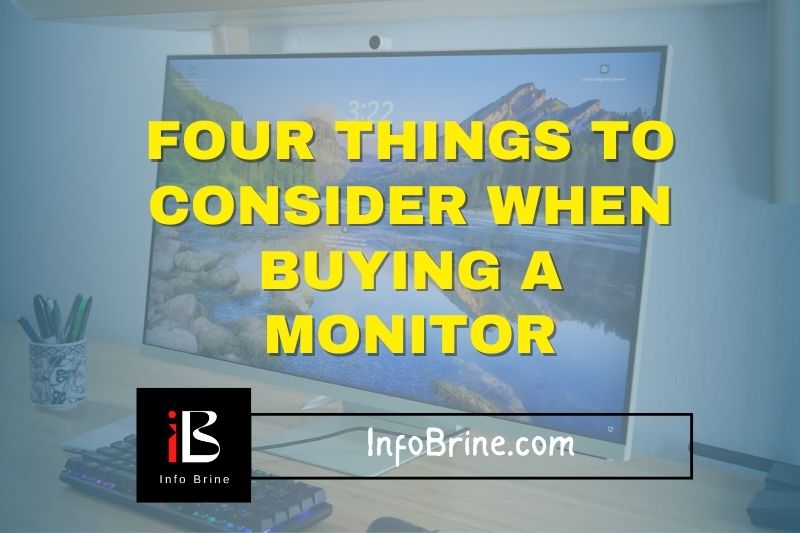When purchasing a monitor, there are four important factors to remember.
Selecting the perfect monitor for your computing needs can significantly enhance your overall experience. Whether you’re a professional designer, a dedicated gamer, or simply looking to upgrade your home office setup, understanding the key factors to consider when buying a monitor is essential. In this guide, we’ll explore the four critical aspects to remember to ensure you make the right choice.
Resolution: Clarity Matters
Understanding Resolution
Monitor resolution refers to the number of pixels that make up the display. It’s a crucial factor in determining the clarity and sharpness of images and text on the screen. Common monitor resolutions include:
- Full HD (1080p): This resolution is suitable for general use, offering sharp visuals for everyday tasks and entertainment.
- 4K (Ultra HD): 4K monitors provide four times the resolution of Full HD, resulting in incredibly crisp and detailed images. They are ideal for professionals working with high-resolution content and avid media consumers.
- Beyond 4K: Some monitors offer even higher resolutions, such as 5K and 8K, mainly targeted at video editing and graphics design professionals.
Choosing the Right Resolution
The choice of resolution should align with your specific use case:
- Full HD (1080p) is often sufficient for most users for productivity and general use. It provides a balance between clarity and performance.
- If you’re into content creation, professional design work, or video editing, consider a 4K monitor. The increased pixel density ensures precise detail and color accuracy.
- Gamers might opt for a compromise, such as a QHD (1440p) monitor, which offers excellent visuals without requiring potent graphics cards.
- When selecting a resolution, consider the size of the monitor and your typical viewing distance. A higher resolution on a larger screen can deliver a more immersive experience but also demands more from your hardware.
Panel Type: Quality and Color Accuracy
Exploring Panel Types
Monitors use different panel technologies, each with its own advantages and disadvantages:
- In-Plane Switching (IPS): IPS panels offer superior color accuracy, wide viewing angles, and excellent image quality. They are suitable for tasks where color precision is crucial, such as photo editing and graphic design.
- Twisted Nematic (TN): TN panels are known for their fast response times, making them popular among gamers. However, they typically have narrower viewing angles and less accurate colors than IPS panels.
- Organic Light-Emitting Diode (OLED): OLED panels provide deep blacks and vibrant colors. They are often found in high-end TVs and increasingly make their way into monitors.
Matching Panel Type to Your Needs
Consider your requirements and preferences when selecting a panel type:
- Opt for an IPS panel if color accuracy and viewing angles are critical, especially for professional work.
- Gamers who prioritize response times may prefer a TN panel but should be aware of potential color limitations.
- OLED panels are known for their stunning visuals but are generally found in premium monitors.
Size Matters: Finding the Right Fit
Screen Size and Productivity
The size of your monitor can significantly impact your productivity. A larger screen provides more screen real estate for multitasking and can reduce the need for scrolling. However, balancing a spacious display and the available desk space is essential. Consider the following:
-
24 to 27 Inches: This is the sweet spot for general office use and productivity tasks. Monitors in this size range offer a good balance between screen real estate and desk space.
-
32 Inches and Above: Larger monitors can benefit if you have ample desk space and desire an expansive workspace. They are excellent for video editing, design work, and immersive gaming.
Gaming and Entertainment
Regarding gaming and entertainment, screen size is critical to your overall experience. A larger screen can immerse you in the game or movie, enhancing the sense of realism.
-
27 to 32 Inches: These sizes are popular among gamers, providing a substantial viewing area without overwhelming your field of vision. Consider a curved monitor for an even more immersive experience.
-
Ultrawide Monitors: Ultrawide monitors, often with a 21:9 aspect ratio, provide an extended horizontal display. They are perfect for gaming and multitasking, allowing multiple windows to open side by side.
Refresh Rate: Essential for Gaming
Understanding Refresh Rate
The refresh rate of a monitor measures how many frames per second (Hz) it can display. A higher refresh rate results in smoother motion and reduced motion blur, making it crucial for gaming.
-
Standard 60Hz Monitors: Most monitors have a 60Hz refresh rate, sufficient for everyday use and office tasks.
-
Higher Refresh Rates: Gamers often prefer monitors with refresh rates of 120Hz, 144Hz, or even 240Hz. These high-refresh-rate monitors deliver smoother gaming experiences, especially in fast-paced games.
Gaming Monitors and Refresh Rate
When choosing a gaming monitor, consider your gaming preferences:
-
Competitive Gaming: A high-refresh-rate monitor can provide a competitive edge if you’re into competitive gaming. Look for a monitor with a refresh rate that matches or exceeds the frame rate your graphics card can achieve in your favorite games.
-
Casual Gaming: For casual gamers, a 60Hz monitor may suffice. However, a higher refresh rate can still enhance your gaming experience if you play various games.
Making the Right Choice
Choosing the perfect monitor involves considering factors that align with your unique needs and preferences. By understanding the importance of resolution, panel type, screen size, and refresh rate, you can make an informed decision that enhances your computing experience.
Whether you’re seeking a monitor for professional work, gaming, or general use, these four critical considerations

